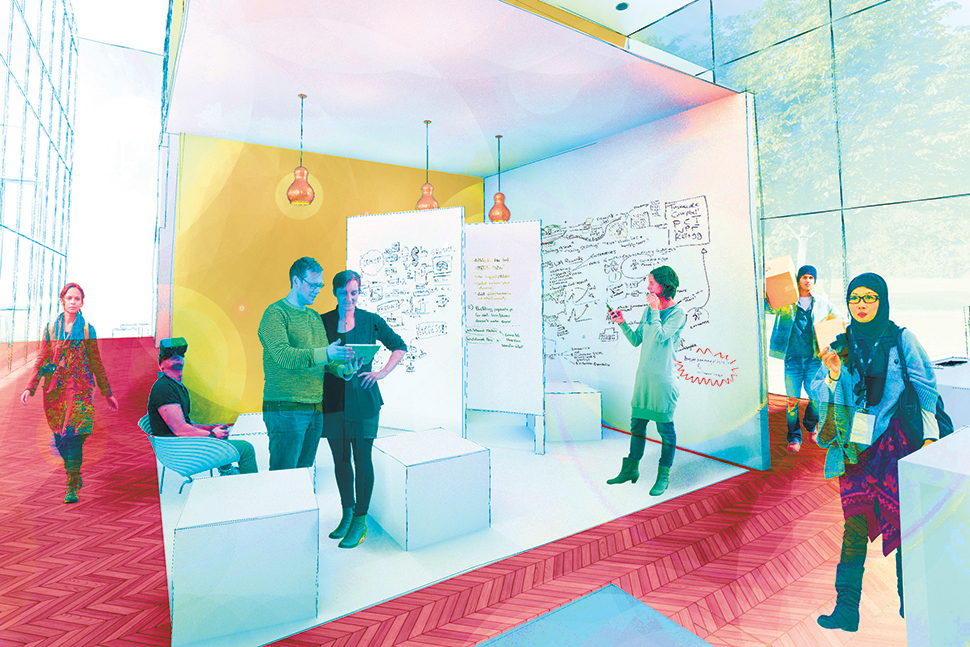
In 1956, Abraham Maslow published a seminal paper on the influence our physical surroundings have on us. Participants viewed photographs of people’s faces and evaluated them based on different attributes. Maslow wanted to test how people reacted to this content while located in different physical environments. Some viewed the images while seated in a beautiful office, while others did so in a grungy janitor’s closet. In the nicer room, people interpreted the faces in the photos as filled with energy and well-being. The same faces were seen as fatigued and sickly when viewed in the run-down room. Maslow surmised that the condition of our surroundings has an impact on not only our emotions but our judgment as well.

Various studies support the notion that space affects our mood and behaviors. From architects and interior designers to psychologists and neuroscientists to community developers and retail managers, numerous experts have discussed the impact of physical environments on the way we think, feel, learn, and act.
Swayed by our surroundings
We each respond consciously (and often unconsciously) to the places where we live, work, hang out, or otherwise inhabit throughout our day. These spaces influence what we get done, whom we engage with, and how we interact with the world around us. In fact, the places where we spend most of our time affect who we are and what we can become. Space shapes us as much as we shape it.
Reading more about the psychological and philosophical nature of space has changed my approach to planning library environments. We have to keep in mind that our efforts are not just about form, function, and efficiency. Our decisions have a direct impact on the cognitive growth and well-being of our communities.
Librarians are increasingly allocating more of their buildings’ physical footprints to classrooms, commons, and specialized studios. This change affords many opportunities for engagement as well as tremendous responsibility. More people are using our services and facilities in different ways. But we are imparting something deeper: We’re influencing how people think and feel about learning, research, knowledge, and themselves.
What makes a space a place?
We are increasingly expanding the spectrum of services in our buildings. From makerspaces and visualization labs to digital scholarship centers and design studios, the library landscape is changing rapidly and radically. But there is one thing we can’t design: a sense of place.
There is much debate about what constitutes a “place” and how it differs from a “space.” After we pored through pages on the topic, it seems that a space becomes a place when it rises above being merely useful. Places have social and personal significance. They mean something to us. We become emotionally invested in a place according to the nature of what we can do in it and how it makes us feel. It is through this process of accruing experiences that a space transforms into a place.
Why is this important? As we reimagine libraries, we want to create opportunities for people to bond with and within our environments. Historically we have been able to point to the stacks and talk about libraries as sacred places because of their collections. But that seems to be changing. If all we are providing is a place to study or a computer lab, that doesn’t particularly require a library. As we face a future with fewer print materials, what factors can transform the library from just another space into a place that is a significant part of someone’s learning and research journey?
Attachment
If we want to elevate the way people feel when they use the library, we need to elevate the way they feel about the library itself. We need to create environments that stimulate an emotional connection. What aspects help foster a sense of place? It’s not cutting-edge technology or designer furniture. It’s not large windows with panoramic views. Nor is it an enormous print collection, a café, or great customer service.
So what is it? The answer might surprise you.
Community developers have found that social ties are the best predictor of strong place attachment. In other words, it’s not the age, condition, or amenities of a place that determine how close our connection to it is. It’s our relationships with the people there.
Studies suggest that students who participate in living-learning residential communities, rather than traditional dorms, perform better academically. They also have an easier time transitioning into college and tend to develop a greater attachment to the institution. While some students and faculty may seek out the library as a place of solitude, the fact is that they are doing so among others who value that same condition. Even if you prefer to be tucked away in the stacks, others around you are also silent and respectful of this shared desire. It’s a community of quiet people.
We become attached to places because of what they enable us to do. They can provide us with energy and support, and they supply us with inspiration and comfort. These places enhance our lives on a continuing basis. If we want students and others to feel this way about libraries, then they need the ability to participate in their surroundings accordingly.
How does this space make you feel?
Libraries have certain noises. Their soundscape, ranging from intense concentration to lively collaboration, is unparalleled. Even our quiet reading rooms have a particular hum—the energy of people surrounded by like-minded people reading, typing, thinking, and dreaming.
We’ve spent years trying to improve this harmony. How can we help people work better? The most valuable insights we’ve encountered have come from sharing space with the students themselves. To understand their situation, we had to experience it firsthand. We needed to work where they worked, see what they saw, and feel what they felt. We needed to inhabit the environment alongside them. So we frequently take our own work into the commons landscape. Over time you recognize a choreography in how a space ebbs and flows between calm and frenetic. You realize that certain people can completely alter the demeanor of a room.
In our conversations with library users, we’ve repeatedly encountered stories from groups and individuals about being able to get things done. A psychological alchemy occurs once people walk through our doors. Visiting a library unlocks certain mental modes, different ways of thinking, seeing, and being. Students and faculty leave our buildings with a sense of accomplishment. A trip to the library is an investment in self-improvement.
We vividly recall a conversation with a student team that expanded our thoughts on common areas. They felt that they could write code together better when working in the library. They admitted that using their laptops enabled them to work anywhere, but the library presented them with a unique combination of features. The mixture of physical, technological, social, and aesthetic components propelled their work. The group members also noted that they always run into old friends or encounter people they don’t see regularly in their classes or residential areas. The value proposition for them is being able to share, move, create, test, and bond in ways they couldn’t achieve elsewhere.
This communal aspect is intriguing. People are not coming to libraries only to get work done; they also want an audience and to join the performance. They position themselves around other people who are working on their own assignments. We’re all in this together. It’s a shared effort. Being surrounded by other productive people is a powerful motivator.
We’ve since noticed related activities. For example, when given an opportunity, many students will alter furniture placement to meet their needs. They might move a table near a window or drag a chair next to a friend. Some will adjust lamps, window shades, or portable partitions. This idea of modifying a room to address immediate needs serves both functional and emotional desires. It’s a key element for encoding space. Our message to them: Make it your own.
Some students feel better sitting a particular way in a particular chair in a particular place at a particular time. A chair is more than just a place to sit; it is an instrumental part of the larger ecosystem and has a direct impact on the pursuit of learning. Places enhance our moods and affect the way we feel about the activities we are doing. As Maslow suggested with his room study, an uncomfortable environment makes working on projects feel more laborious, whereas an inspiring environment uplifts the spirit, bringing about greater results.
Space imparts action
Imagine you are teaching in a classroom filled with rows of desktop computers. What impact does this arrangement have on your approach? Now imagine that you are in a room outfitted with movable furniture, portable whiteboards, and a cart of laptops. Would you teach differently? One setup isn’t necessarily better than the other; they each enable different things to happen. If you are demonstrating software and want people to follow along, then the fixed room would be suitable. If you want students to move about and interact in small groups, then the flexible arrangement is more ideal.
The space affects what we can do within it. You’ve probably experienced this during meetings. A circular setup creates a different dynamic than one featuring a long rectangular table. The configuration of the furniture affects the way people engage with one another and the manner in which topics are discussed. There is a big difference between sharing information and shaping it together. Our job, then, is to think about the wide array of interactions (behaviors) that we want to support and then to develop spaces that encourage those outcomes.
Programmable space
One of the most valuable ways to think about physical space is to compare it with virtual space. If you manage a website, there are things you can do to influence how it is used, from selecting certain colors, fonts, and graphics to presenting content, navigation, and interactive components. Information architecture works behind the scenes to bring it all together.
Analytics, usability testing, and other tools allow you to monitor the actions occurring across your pages. You can change settings to make your site better: Rename links, resize images, move text, or place greater emphasis on certain areas. By modifying code, you modify the virtual environment and ultimately how people experience your web presence. Changing the environment influences people’s behaviors.
We view library buildings in the same manner: It is all programmable space. We can move book stacks, computers, or study carrels and arrange them differently. We can introduce temporary features such as exhibits, installations, or events. We can optimize certain areas depending on how they are framed and where they are located throughout our buildings. We can alter experience (and behaviors) by altering the environment.
An idea that sparked our imagination was a series of experiments conducted in school cafeterias. Researchers found that they could influence student’s food selection simply by arranging the choices in different ways. For example, they increased healthy eating by emphasizing certain foods and deemphasizing others, even when the same inventory was available. What really mattered was how the food was presented as students moved through the line. Easy access to healthy food early on was the critical factor.
This is a powerful concept. It encourages us to think of ourselves as choice architects, not just learning space managers. A library building presents visitors with many choices, and patrons have to make a series of decisions about what they need for the task at hand. We are presenting them with a physical interface. As they navigate our spaces, they are exposed to many different possibilities. Our task is to apply the principles of usability and offer intuitive options. In this manner we become interaction designers, creating a diverse range of settings for a variety of intended outcomes.


